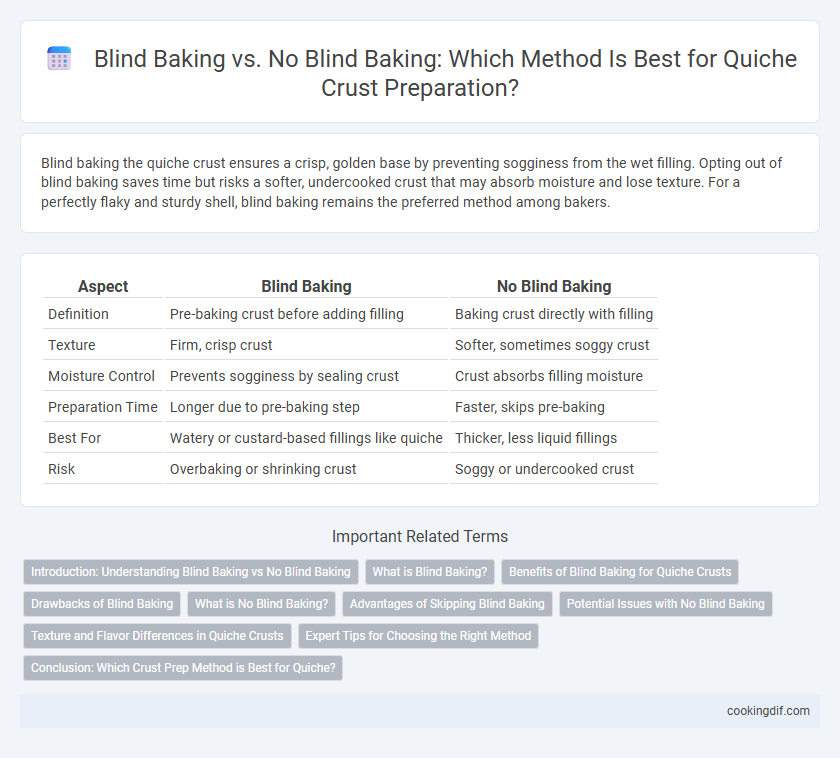Blind baking the quiche crust ensures a crisp, golden base by preventing sogginess from the wet filling. Opting out of blind baking saves time but risks a softer, undercooked crust that may absorb moisture and lose texture. For a perfectly flaky and sturdy shell, blind baking remains the preferred method among bakers.
Table of Comparison
| Aspect | Blind Baking | No Blind Baking |
|---|---|---|
| Definition | Pre-baking crust before adding filling | Baking crust directly with filling |
| Texture | Firm, crisp crust | Softer, sometimes soggy crust |
| Moisture Control | Prevents sogginess by sealing crust | Crust absorbs filling moisture |
| Preparation Time | Longer due to pre-baking step | Faster, skips pre-baking |
| Best For | Watery or custard-based fillings like quiche | Thicker, less liquid fillings |
| Risk | Overbaking or shrinking crust | Soggy or undercooked crust |
Introduction: Understanding Blind Baking vs No Blind Baking
Blind baking, also known as pre-baking, involves baking the quiche crust before adding the filling to prevent sogginess and ensure a crisp texture. Opting for no blind baking may result in a softer crust as the filling cooks along with the dough, suitable for recipes with sturdier fillings like quiche Lorraine. The choice between blind baking and no blind baking depends on the moisture content of the filling and desired crust texture, impacting the overall quality of the quiche.
What is Blind Baking?
Blind baking is the process of pre-baking a pie or quiche crust without the filling to prevent sogginess and ensure a crisp texture. This technique typically involves lining the crust with parchment paper and filling it with pie weights or dried beans to maintain its shape during baking. Blind baking is essential for custard-filled quiches to achieve a fully cooked, firm crust that holds the filling without becoming soggy.
Benefits of Blind Baking for Quiche Crusts
Blind baking quiche crusts prevents sogginess by ensuring the pastry is fully cooked before adding the filling, creating a crisp and firm base. This technique minimizes moisture absorption from custard or vegetable fillings, preserving the crust's texture and structural integrity. Achieving a golden-brown crust through blind baking enhances both flavor development and visual appeal in quiche dishes.
Drawbacks of Blind Baking
Blind baking quiche crust can lead to over-drying and shrinking, which affects the final texture and appearance. The process may cause the crust to become too crisp, resulting in a less tender bite compared to unbaked crusts. Furthermore, blind baking adds an extra step and time to preparation, reducing overall cooking efficiency.
What is No Blind Baking?
No blind baking refers to preparing the quiche crust without pre-baking it before adding the filling, allowing the crust to bake fully with the custard. This method saves time and ensures a softer, more tender crust, though it may result in a slightly less crisp texture compared to blind baking. Choosing no blind baking can be ideal for quiches with moist fillings where a flaky crust without excessive hardness is preferred.
Advantages of Skipping Blind Baking
Skipping blind baking when preparing quiche crust preserves the buttery texture and prevents over-drying, resulting in a flakier, more tender base. It saves time and simplifies the process by eliminating the need for parchment paper and weights, making crust preparation less labor-intensive. This method also reduces the risk of shrinking crust edges, maintaining an even, visually appealing quiche shell for baking.
Potential Issues with No Blind Baking
Skipping blind baking when preparing a quiche crust can lead to a soggy bottom due to insufficient barrier formation, allowing the filling's moisture to seep into the pastry. The raw dough may also puff up or shrink unevenly during baking, compromising the crust's structural integrity and texture. Without blind baking, the quiche might have an undercooked or doughy base, impacting overall flavor and consumer satisfaction.
Texture and Flavor Differences in Quiche Crusts
Blind baking quiche crust produces a crisp, flaky texture by ensuring the crust is fully cooked before filling, preventing sogginess from moist ingredients. Skipping blind baking often results in a softer, more tender crust that absorbs flavors from the filling, enhancing overall richness but risking a less structurally firm base. The choice impacts flavor depth and texture balance, with blind baking favoring a distinct contrast between crust and filling, while direct baking creates a harmonious, melded taste experience.
Expert Tips for Choosing the Right Method
Expert tips for choosing between blind baking and no blind baking hinge on the type of quiche filling and desired crust texture. Blind baking is recommended for custard-based quiches with high-moisture fillings to prevent a soggy crust by pre-baking the pastry until golden and firm. For quiches with thick or pre-cooked fillings, skipping blind baking can save time and result in a flakier crust that crisps up during baking.
Conclusion: Which Crust Prep Method is Best for Quiche?
Blind baking creates a crisp, firm crust by pre-baking it before adding the filling, preventing sogginess in quiche. Skipping blind baking results in a softer, sometimes undercooked crust that may absorb moisture from the custard filling. For a perfectly textured quiche, blind baking the crust is the optimal preparation method, ensuring structural integrity and enhanced flavor.
blind baking vs no blind baking for crust preparation Infographic

 cookingdif.com
cookingdif.com